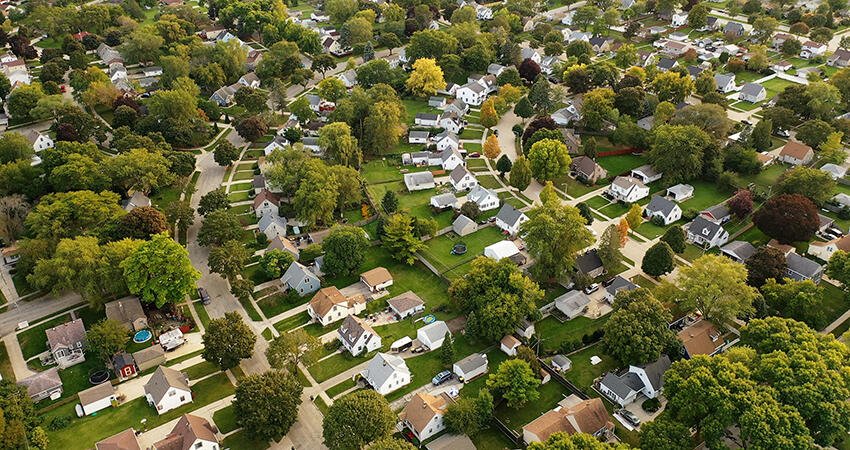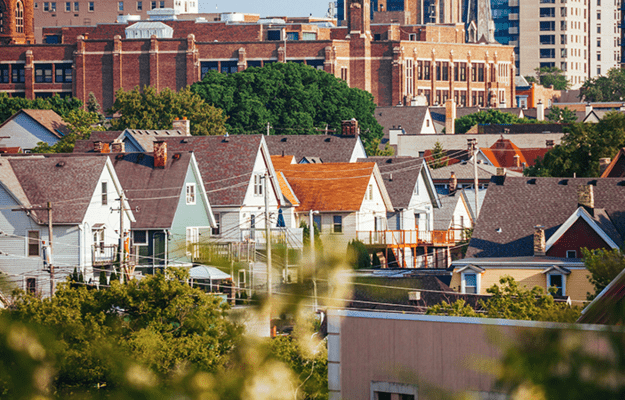
(Alena Mozhjer/Shutterstock)
How Do Neighborhood Energy Efficiency and Carbon Emissions Vary Based on Residents’ Race and Ethnicity?
- Title:
-
Racial inequity in household energy efficiency and carbon emissions in the United States: An emissions paradox
- Author:
-
Benjamin Goldstein, Tony G. Reames, Joshua P. Newell
- Source:
- Publication Date:
-
2021
Residential energy use accounts for 17 percent of total annual carbon emissions in the United States. And research shows that racist housing policies and practices have negatively affected housing quality and homeownership rates in communities of color—which are both determinants of household energy use and carbon emissions. So how do race and ethnicity affect energy use and emissions? A recent study explored this question by estimating energy use and emissions of 60 million US households.
To conduct the study, researchers estimated the total energy use, energy-use intensity, and per capita carbon emissions of those US households using a combination of emissions, energy, and housing data from the 2015 US Energy Information Administration Residential Energy Consumption Survey, CoreLogic (the background data for Zillow) and the US Environmental Protection Agency’s eGrid database.
To assess variations across race and ethnicity, researchers aggregated estimates at the zip code level and used demographic data to classify the zip codes as majority white, Black, Latinx, or “other” in the cases where zip codes lacked a racial or ethnic group that made up over 50 percent of the population. They calculated emissions per capita by dividing the total emissions from home energy use in a neighborhood in 2016 by the 2016 Census population estimates for a neighborhood. They derived energy-use intensity as total energy consumption in each neighborhood divided by the total floor area of housing in a neighborhood. Using the zip code–level data, researchers developed statistical models to analyze links between race, per capita emissions, and energy-use intensity and to identify the key factors affecting energy use and emissions trends such as housing quality, prevalence of owner-occupied units, and proximity to formerly redlined neighborhoods.
The study finds that neighborhoods with mostly white residents have high per capita emissions despite having low energy use per square meter, and neighborhoods with a majority of Black residents emit less carbon but live in comparatively energy-inefficient homes. Latinx communities have the lowest per capita emissions and energy use per capita. Factors including floor area (which is higher in neighborhoods with predominantly white residents, compared with neighborhoods with mostly Black and Latinx residents), housing quality (which is highest in mostly white neighborhoods), and homeownership (which is higher in predominantly white neighborhoods) all influence these results.
Key findings
- Per capita emissions by race: Across the US, per capita emissions are highest in neighborhoods with mostly white residents. This is followed by neighborhoods with mostly Black residents, where emissions are 90 percent of those in majority-white neighborhoods. Latinx neighborhoods have the lowest per capita emissions, at only 60 percent of majority-white neighborhoods. Emissions from neighborhoods without a racial or ethnic majority are 70 percent of those in majority-white neighborhoods. These trends hold independent of climate, building age, income, and characteristics of the electrical grid.
- Energy-use intensity by race: Neighborhoods with mostly Black residents have the highest energy-use intensity despite being concentrated in areas with lower thermal demands relative to mostly white neighborhoods. Majority-Latinx neighborhoods have the lowest energy-use intensity of any race or ethnic group, likely because of the lower thermal demands of southern and western states, where majority-Latinx neighborhoods are primarily concentrated. Energy-use intensity is also markedly higher in neighborhoods that experienced redlining, and these neighborhoods are twice as likely to be majority Black than majority white.
- The role of floor area: Emissions rise in tandem with floor area per capita because larger floor areas require more energy for space heating and cooling, appliances, and lighting. Floor area per capita is highest in neighborhoods with majority-white residents, which helps explains why these neighborhoods have the highest per capita emissions despite residents living in relatively energy-efficient homes. In neighborhoods with mostly Black residents, floor area per capita is 23 percent lower than majority-white neighborhoods, which helps explain why their overall per capita emissions are low despite high energy-use intensity. In majority-Latinx neighborhoods, floor area per capita is 41 percent lower than majority-white neighborhoods, which, taken together with low energy-use intensity, explains why predominantly Latinx neighborhoods have the lowest per capita emissions.
- The role of housing quality: Energy-use intensity increases with building age, primarily because of outdated equipment and poor weatherization. Homes in majority-Black neighborhoods are on average a decade older than those of other groups, and national surveys indicate that Black households are likely to have homes with poorer insulation and older heating equipment and appliances, which help explains the high energy-use intensity.
- The role of housing tenure: As the percentage of renters in a particular neighborhood increases, the energy-use intensity rises. This is partially explained by the split incentive, in which landlords rarely pay utility bills and, thus, have little incentive to invest in energy efficiency retrofits. As a result, renter households face increased utility bills, which can exacerbate energy poverty. Renting is more common in majority-Black neighborhoods, as is the percentage of income that goes toward energy bills, total energy costs, and the likelihood of forgoing essential purchases, such as food and medicine, to pay energy bills.
Policy implications
To equitably reduce energy use and emissions across communities and promote energy justice, the authors recommend the following policy measures:
- Finance energy efficiency retrofits, especially in Black and Latinx communities, and address the split incentives between landlords and renters. To address capital gaps, policymakers could consider forming a national green bank to provide long-term funding to national energy efficiency programs and expanding existing grant and lending mechanisms, like the US Department of Energy’s Weatherization Assistance Program, that provide resources to help households with low incomes weatherize their homes. To address the split incentive, programs and policies should balance incentivizing landlords to invest in energy efficiency while keeping rents affordable. Example solutions might include designing retrofit programs that enable tenants or landlords to repay energy retrofit loans as part of the utility bills, with energy savings outweighing retrofit costs. It may also be necessary to compensate landlords through reimbursements on utility bills, renovation tax breaks, or direct compensation.
- Increase equitable access to rooftop solar. In the US, residential solar panels can support 75 percent of total residential electricity consumption, but adoption of rooftop solar has been 30 to 69 percent higher in majority-white neighborhoods than in majority-Black and -Latinx neighborhoods. A national solar incentives program that targets disadvantaged households and involves community-centered approaches could help expand the adoption of low-carbon residential options that reduce emissions and provide energy security.
- Disincentivize high energy consumption and emissions. Disincentives may be needed to encourage high-emitting households, especially in larger homes, to make necessary energy efficiency investments, such as mandating quantitative energy efficiency improvements or imposing fees for households that fail to meet per capita energy-use intensity benchmarks. Any disincentive systems should be means tested to ensure penalties are not an unfair burden for low-income households.
- Proactively address energy use and carbon emissions in new home construction. Changes to zoning codes and requirements can help reduce future energy needs and related carbon emissions for the tens of millions of homes that will be built in the US in coming decades. Denser settlement patterns that prioritize multifamily apartments over single-family homes can also reduce household energy use and carbon emissions.


